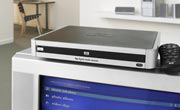Hewlett-Packard on June 10 unveiled a $349 digital receiver that brings video and audio content from the PC or Internet to any high-definition television set. One month earlier, Netflix had unveiled a $99 set-top box that directs movies and TV shows from the Internet to its subscribers’ TVs. Meanwhile, Apple has been building out the services connected to its Apple TV product, inking a deal with HBO in May to bring shows like “The Sopranos” from its iTunes store to widescreen televisions. The common thread: All these companies are building a bridge from the computer to the television.
What’s unclear is whether any of these efforts will ultimately be successful. The technology — wireless connections and broadband access — is there to connect the Internet to traditional television sets, but the effort to deliver entertainment to any device is fraught with uncertainty, say experts at Wharton. The biggest hurdle for these newfangled set-top boxes is that consumers have to change their behavior to accept interactive television. Do consumers really want to watch a YouTube clip on the widescreen?
In addition, the efforts of Netflix, Apple and HP are all based on closed systems. Apple TV, which starts at $229, connects with iTunes. Netflix’s box offers only films from the service’s “Watch Instantly” selections and requires a Windows-based PC. And while HP’s digital receiver — called the HP MediaSmart Connect — supports a number of different PC-based video and audio formats, it is built on Microsoft’s Windows and supports only the CinemaNow service for purchase or rental of feature films. In other words, there isn’t a perfect digital media convergence box.
“A lot of content is available for on-demand viewing,” says Kendall Whitehouse, senior director of information technology at Wharton. Citing the selection of movies and television programs available online through Hulu.com, a web site recently launched through a partnership of NBC Universal and News Corp., he notes that “the startup time is instantaneous and the quality is good. So what’s the problem? I’m sitting at my PC and want to view it on my TV. I want to put it on the right screen at the right time at home. The challenge is those last three yards between the Internet and the TV.”
Indeed, depending on what services a consumer has, it’s possible that one entertainment center could have multiple set-top boxes, including those from incumbent cable providers such as Comcast and Time Warner.
Nevertheless, technology companies are sold on the concept of the digital living room — where content is interactive and delivered via multiple channels, including cable, wireless and the Internet. Companies such as Netflix, Disney, Amazon.com and Apple are expanding the digital distribution of media. Disney on June 10 said it will show movies such as “Finding Nemo” online in a joint effort with its ABC network. Paul Yanover, executive vice president and managing director of Disney Online, said in a news release that the effort is “another example of how Disney’s content can be leveraged on multiple platforms.” In addition, cable and telecommunication companies like Comcast and Verizon are making their set-top boxes more interactive.
Experts at Wharton say these efforts are creating a bridge between the personal computer and the TV, but are based on the assumption that the two devices will converge. However, David Hsu, a management professor at Wharton, says that assumption is no sure bet. Hsu argues that there is a disconnect between the digital living room vision and what consumers actually do. “Theoretically, it should be the case that there’s a lot of convergence between the PC and TV and content evolution. But on the demand side, it’s unclear what consumers want.” The solution is to try many different business models, says Hsu.
According to Wharton business and public policy professor Gerald Faulhaber, it’s also unclear whether consumers even want the digital living room as proposed by technology and media companies. “[Shuffling content between various devices] is only a real problem for a small number of people. There’s just not a lot of demand for these efforts right now,” says Faulhaber.
Whitehouse is more hopeful. “There is a market niche that’s not being met. Although it is relatively small right now it will grow quickly,” he predicts.
The State of Convergence: Flux
Wharton professors agree that the so-called digital living room and all the media convergence that goes with it is in flux. And it’s possible that the entire concept of the digital living room is flawed, that perhaps the TV and PC simply aren’t meant to converge. Wharton marketing professor Peter Fader says the digital living room analogy is off-base in many respects. “The whole digital living room idea misses the point. A nice analogy is, ‘What am I going to do for dinner tonight?’ I can go to a fancy restaurant. Or just get a burrito. It’s all about convenience and control. The microwave burrito is watching video on your PC. The fancy restaurant is the big screen in your living room and the immersive experience. You’ll do both.”
Fader and others point out that the basic infrastructure is in place to begin to meld together the worldwide web and home entertainment systems. For instance, some media companies are delivering content through multiple platforms — online, wireless and cable. But until the interoperability problem is solved, consumers will continue to find it difficult to bridge the PC with the television. “Everyone is too beholden to their boxes,” Fader notes. “Companies are a little more fixated on the technology and gadgets than the services” when they should instead be focusing on making it easier to consume content on any device.
Looking for a Halo
One reason these digital living room technologies are closed to each other is because companies are trying to reproduce Apple’s so-called “halo effect,” where one device or service stokes demand for other products from the same company.
Every company targeting the digital living room has different motives. Whitehouse says that Netflix, to its credit, is looking past the day where its core business — delivering DVD rentals by mail — starts to decline. Amazon has adopted a similar strategy: Selling music and movies digitally can be more profitable than shipping them on physical media. “I give both Netflix and Amazon credit. They are looking beyond their current models and playing with new ones,” says Fader.
As for media companies, they continue to experiment with new ventures such as Hulu, which provides full-length movies and television programs online for free with advertising. Other services offer download-to-own or video rental business models. According to Hsu, some of these business models are likely to pan out. The challenge will be delivering technology and services that can’t be replicated by incumbents such as the cable companies, which already deliver on-demand video through their set-top boxes.
“The value for companies will emerge when they come up with something that cannot be replicated by Comcasts in the world. Netflix has made some strides here by allowing subscribers to manage their movie queue online. But I would say it has to go beyond that,” says Hsu.
For now, however, companies targeting the digital living room are more often than not emulating what the cable companies already do. The more successful models are subscription based or pay-per-view and involve a set-top box. “The rationale for all these set-top boxes is that consumers want to interact with devices in a way they already know,” Hsu notes.
Indeed, one of the biggest hurdles for these new entertainment delivery business models is consumer behavior, he adds. Consumers are not used to combining the functions of a TV and PC and sharing content between them. Hsu expects more innovation and experimentation to come. “Technology is getting sophisticated and there will be some meld of the PC, TV and Internet. But what’s going to get people to switch over to interacting with these appliances and machines? There will have to be something that’s fundamentally different than what’s on TV.”
The Bandwidth Battle
On the surface, bridging the gap between the TV and PC isn’t a difficult technology problem, according to Faulhaber. For instance, Wi-Fi wireless networking is an easy way to share data between the PC and TV, and many companies are using that technology.
Where Faulhaber expects complications is bandwidth management. For instance, the bandwidth used to download and stream video through new services from Netflix, Amazon and Apple doesn’t amount to much. However, if these digital living room services take off, there could be a bandwidth squeeze that creates problems for companies like Verizon and Comcast that offer competing services — and the broadband pipeline that delivers them to the home, says Faulhaber, adding that control over what gets in the pipeline could be a more contentious issue if Internet TV services become popular.
“Most of these set-top boxes use cable broadband as a separate distribution channel, but it’s not quite as separate as it seems because it’s all coming over a cable modem,” Faulhaber says. “This could become an issue if Internet TV really takes off. If streaming video over broadband networks becomes popular, there may be limitations placed on it because the networks may not be able to carry it all. Some accommodation will have to be made because there will be 20 pounds of content in a three-pound bag. When we start pushing TV down the broadband channel, there will be issues.”



